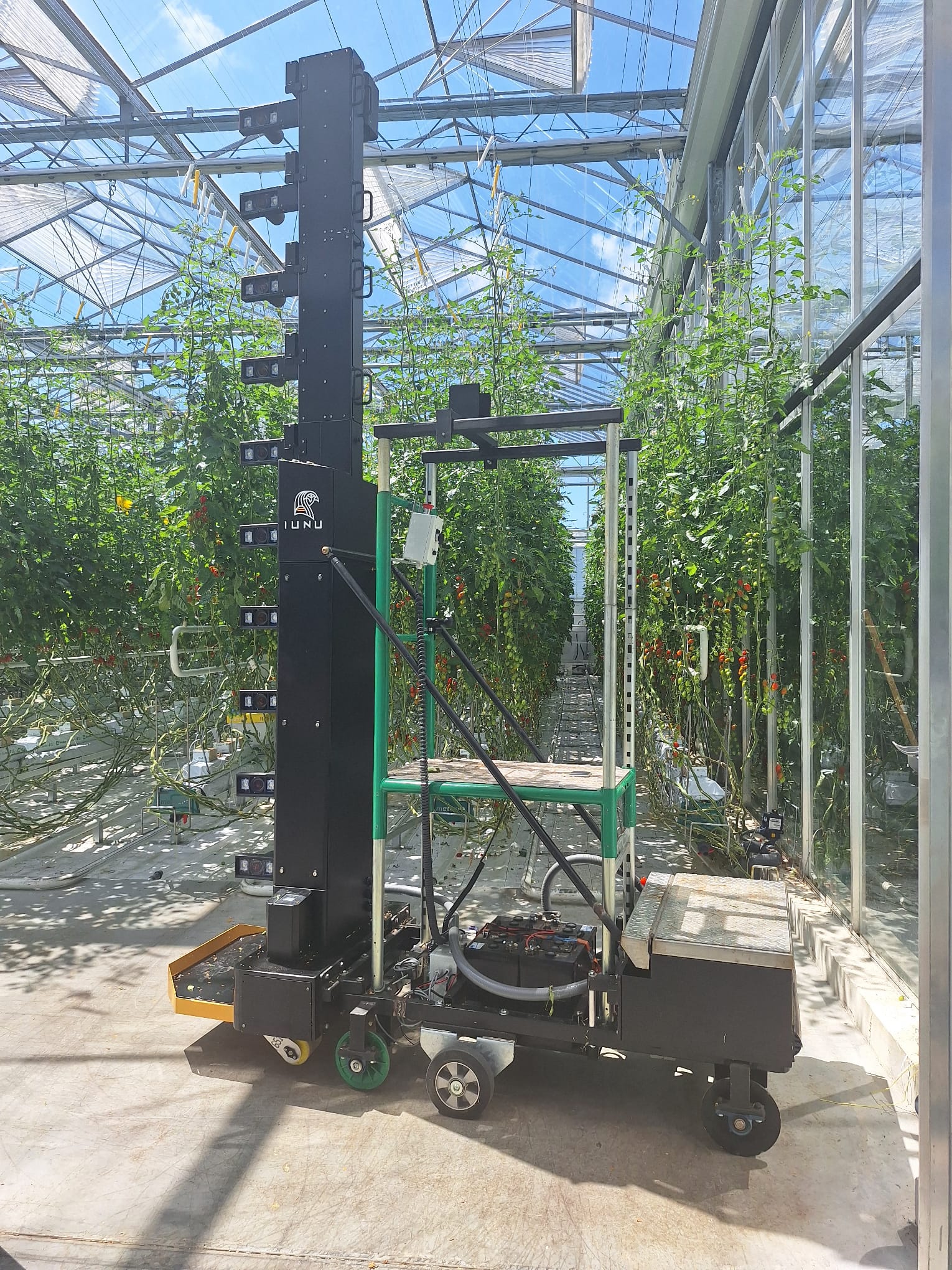
The IUNU Mast is a highly advanced imaging system for greenhouses. The images generated are analysed in real time using AI, and the system makes data-based predictions about plant growth, yields, labour requirements, pest infestation and more.
Pim van Adrichem, HortiTech, in dialogue.
Pim van Adrichem is co-founder and director of HortiTech, a Dutch company specialising in research, training and consultancy in modern greenhouse horticulture. The company aims to bridge the gap between theory and practice and is characterised by application-oriented innovation and efficient knowledge transfer. In our interview, Pim talks about the role of robotics and AI in horticulture.
Pim, what challenges is the horticultural sector currently facing?
In the Netherlands, these are primarily the high energy prices and the availability and affordability of labour. Another point is certainly the further development of green methods for crop protection, which are increasingly being demanded by customers. There is still a lot of room for improvement and it will take time and investment.
How can the use of robotics and/or AI help to overcome these challenges?
Robotics and automation can certainly replace human labour, for example in sowing, plant care and harvesting. AI, on the other hand, can be very supportive in many work processes from middle management upwards. AI will by no means replace management, but it will make their work more efficient. For example, a grower managing 10 hectares without AI can manage 40 hectares in the same time with AI. That’s a clear competitive advantage.
How is robotics already used in horticulture today – and how do you see it developing in the future?
I currently see a discrepancy between supply and demand. There are many providers of good robotics solutions. The market is interested, but not buying. Many horticultural businesses are waiting for the second, even more efficient and – hopefully – cheaper generation of robots. But if everyone waits, horticultural robotics cannot develop further.
Apparently the pressure is not yet high enough. Many in the industry believe they can manage without robots. And they currently do.
Personally, I also see a societal relevance here. If robots replace workers in horticulture, those workers can be retrained and employed in other sectors. I could well imagine that robotics solutions could become more affordable through government subsidies and thus indirectly help solve problems not directly related to horticulture. It’s all very complex. But I think we should definitely look beyond the boundaries of the sector and consider the bigger societal picture. That’s my personal opinion.
Will robotics and AI become widely accepted in horticulture? What do you think?
Robotics is not currently being used on a large scale. Companies often do not see sufficient financial incentive. This is because robots do not work better than human labour and are not cheaper either. Instead, they have to adapt to their 24-hour use, which initially involves more organisational effort.
So the costs for the robots would have to fall. This can only succeed if there is either funding and/or manufacturers improve their production – e.g. through more standardised processes. There are many robotics providers, which creates a nice dynamic. But everyone is doing their own thing, developing and producing their own robot arm, for example. That is expensive. If there were more standards here, things would look different. I’m sceptical about robotics. If nothing changes in the next two or three years, we’ll be stuck in a dead end.
The situation is very different with AI. There are already very good AI solutions that can be used directly and immediately make existing processes more efficient. There is also a reasonable pricing policy overall. Investments in AI are generally manageable and amortise quickly.
But we have another obstacle, at least in the Netherlands. The successful horticultural professionals think: “AI can’t be better than me.” But that’s not the point: AI is not better, but it makes you better. We see this with producers in the USA, who rely a lot on AI. And are developing faster and better as a result.
I think there will be a snowball effect. If someone is successful with AI, others will follow the same path. Sooner or later, the use of AI will be an integral part of modern horticulture.
In May, you were a speaker at the International Sales Force Conference of Gartenbau-Versicherung. What was your experience of the event and how can Gartenbau-Versicherung promote innovation in horticulture?
My presentation was received with great interest and we had a very intensive professional dialogue. That was a great experience for me. I could tell that your sales force is very familiar with the market and knows what challenges producers are facing.
With its technical expertise, Gartenbau-Versicherung can act as a driving force by being open to innovations itself, taking these into account in product development and making well-founded statements about them in consultations with member companies. In this way, as the specialist insurer of European horticulture, you make a considerable contribution to advancing developments. You have your eyes and ears directly on the market, can inform, support and speak to your policyholders at eye level. That carries weight.
If you could give one piece of advice to a horticultural business, what would it be?
Keep your eyes open. Find out about innovations in horticulture. You don’t have to follow every trend, but you should be aware of what is happening on the market. Standing still is not a long-term solution.
We are there for you.
Our insurance solutions are characterized by their modular structure.
This allows us to offer you comprehensive insurance cover that is individually tailored to your business.
Find out more now at https://Gartenbau-Versicherung.de/sicherheit/ or contact your local risk consultant.
